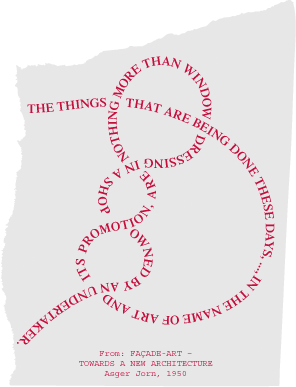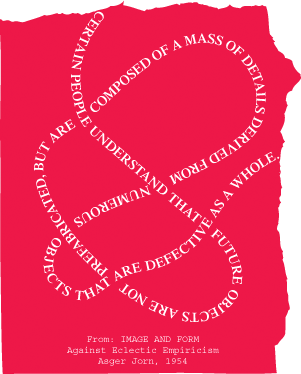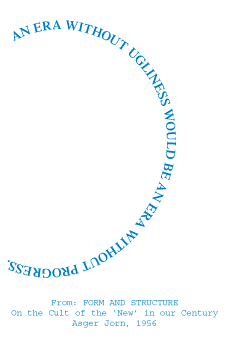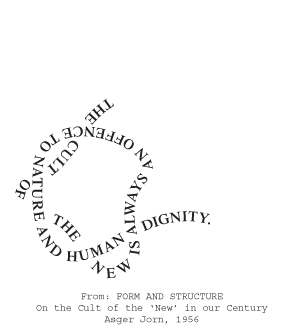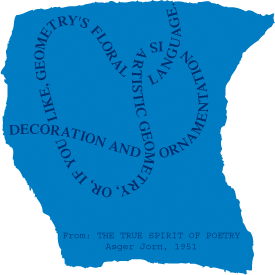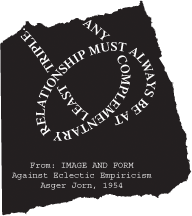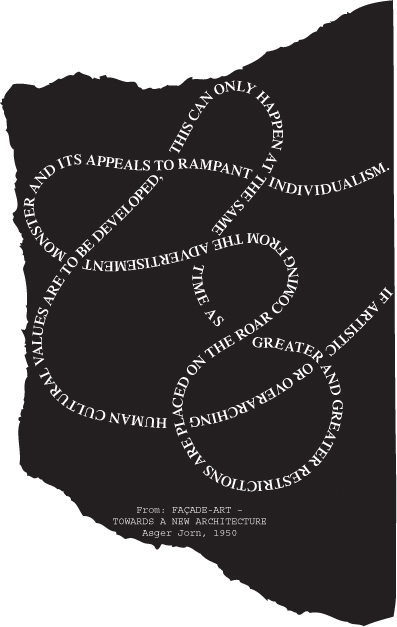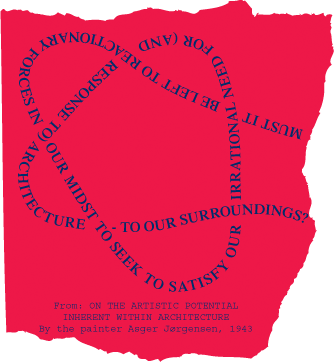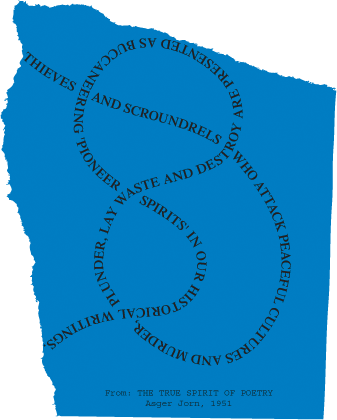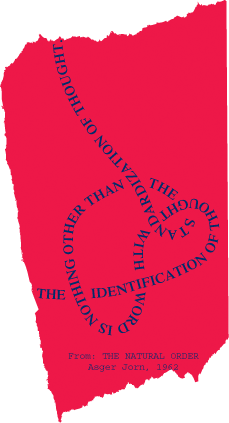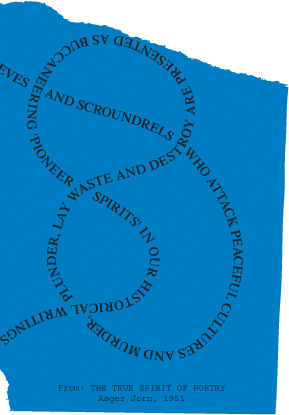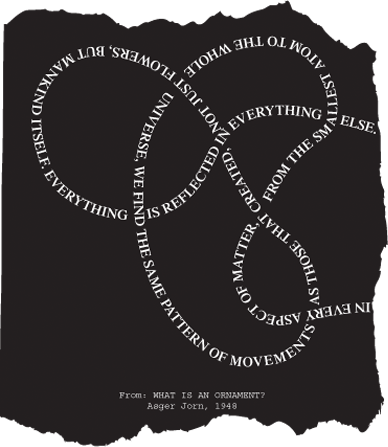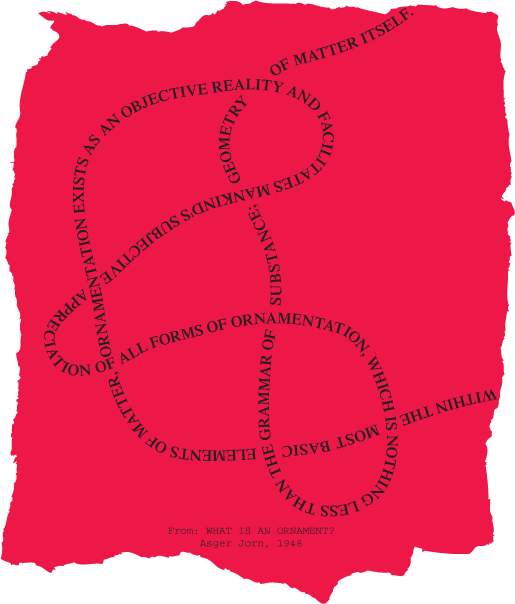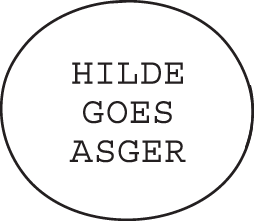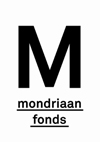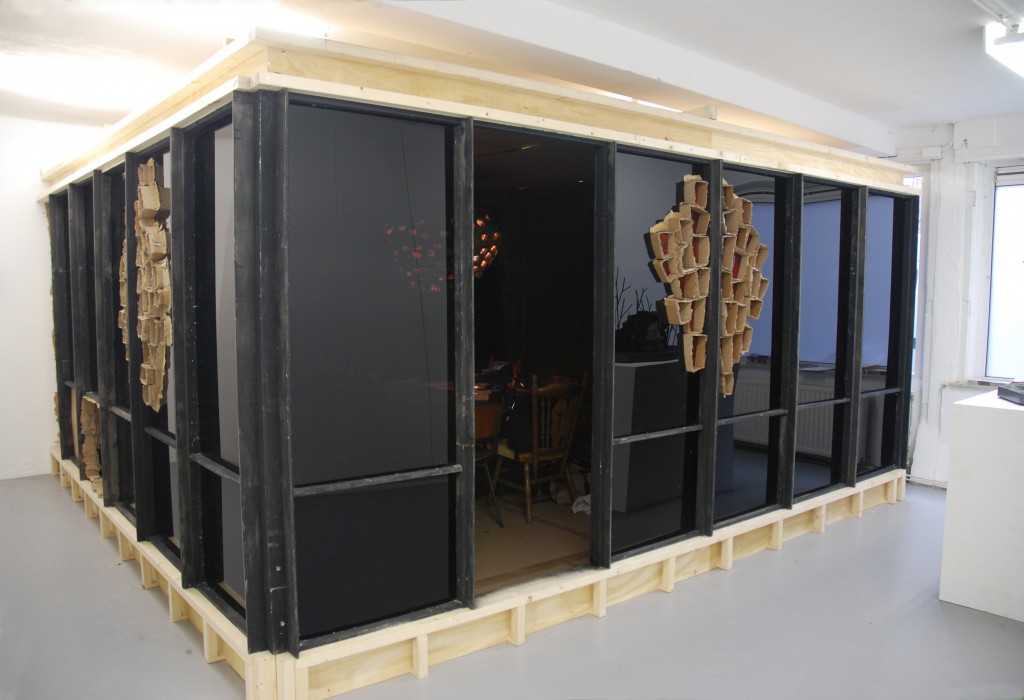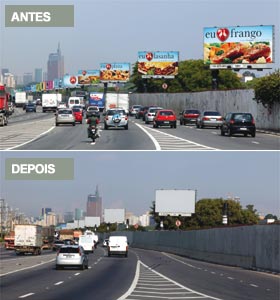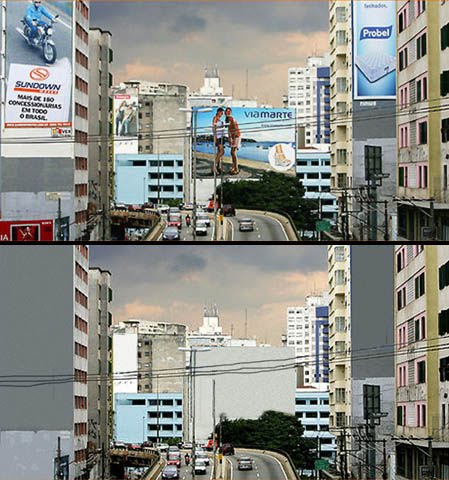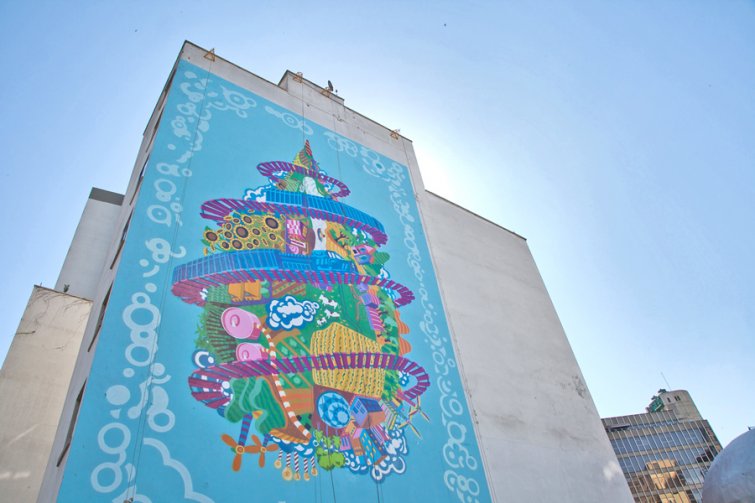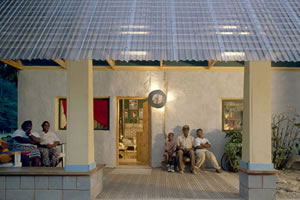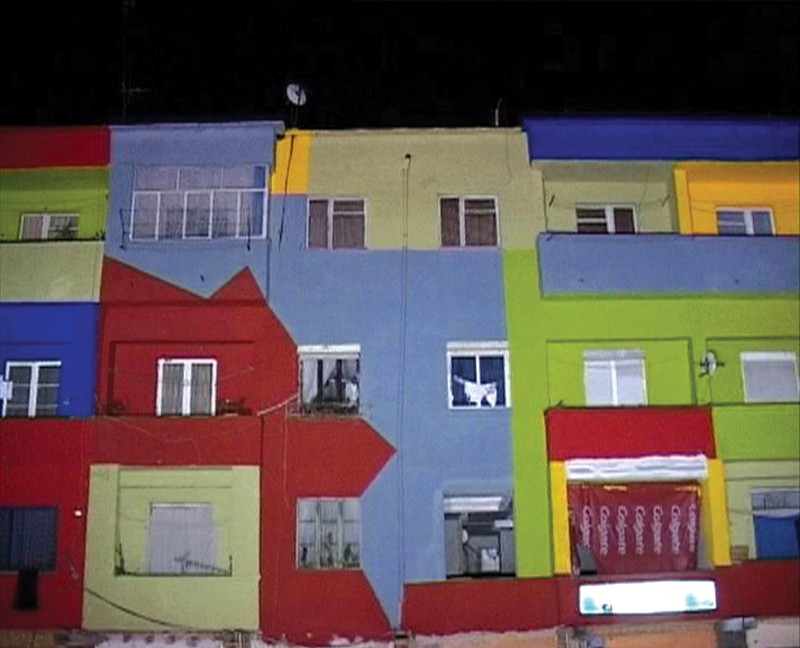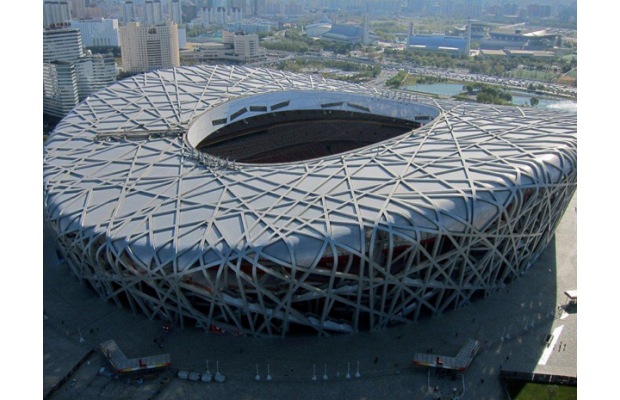L’ARCHITECTURE SAUVAGE – ASGER JORN’S CRITIQUE AND CONCEPT OF ARCHITECTURE
Within the framework of my research into Asger Jorn´s writing and thinking I organize public sessions with special guests at a variety of venues. The guest´s practice, knowledge, insights, or responses are informative to my research, or steer the direction I take on a particular topic. The sessions also often respond to the context of the hosting institution, or to a specific request. Making the sessions public is a way to share and enter into a dialogue with the audiences.
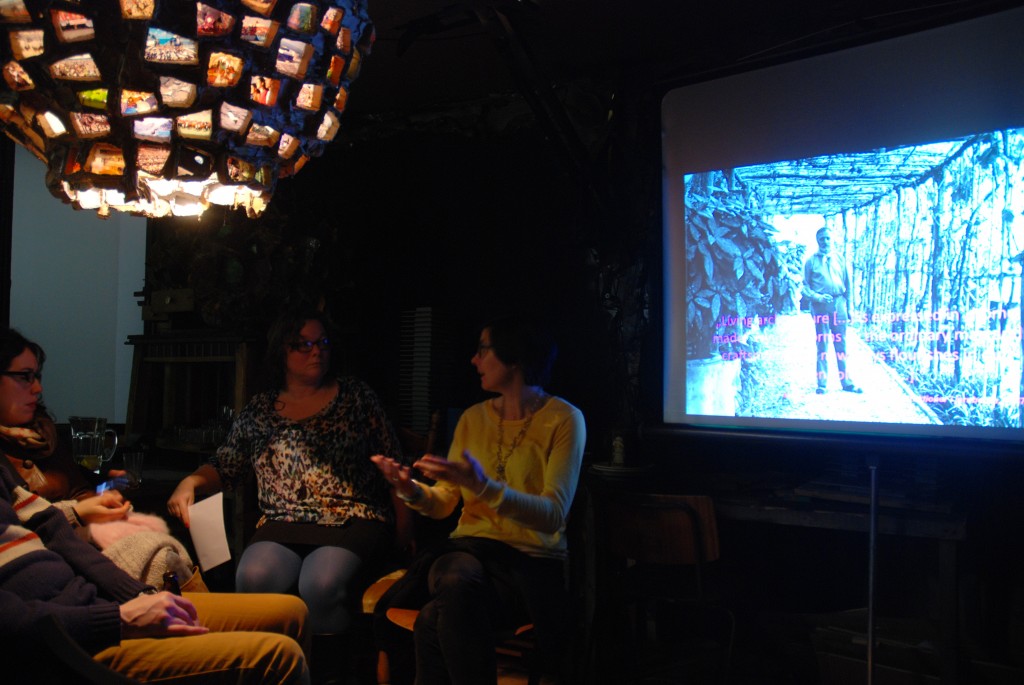
Ruth Baumeister giving a talk inside Rob Voerman’s installation ‘The Fifth Season’, Upstream Gallery Amsterdam, 2014.
L’ architecture sauvage was a talk and interview with Silkeborg-based researcher, critic and teacher Ruth Baumeister at Upstream Gallery, Amsterdam. This session took place Saturday 22 February 2014.
Rob Voerman’s architectural installation ‘The Fifth Season’ conceptually and physically framed the event. As an artist, for the past few years Rob has been creating large-scale installations that are accessible to visitors. The Fifth Season has an additional layer or function, which is to bring people together for meetings, talks, and dinners revolving around the central question of how art and engagement can co-exist. One source of inspiration for Rob´s installation were the ideals of the Bauhaus School. Architect Mies van der Rohe worked within Bauhaus (last director 1930-1933) before moving to the United States in 1937. Here, he designed various iconic buildings that art historically speaking are considered the basis for modern day skyscrapers. Despite the fact that Bauhaus was known for its ideological and socialist character, the buildings Van der Rohe designed were mostly expensive hotels for the upper class. ´The Fifth Season´ is particularly inspired by Van der Rohe’s Seagram building in New York dating from 1958. The Seagram Building is one of the best known buildings by Van der Rohe and right from the start it housed the elitist Four Seasons restaurant. In the 1950s artist Mark Rothko was commissioned to create a series of paintings for the restaurant. The story goes that that Rothko accepted the commission but without telling anyone decided to create “something that will ruin the appetite of every son-of-a-bitch who ever eats in that room.” (Wikipedia) By the time the works were installed however, Rothko decided that the works would “be nothing more than a decorative element in a space where the rich enjoyed their overpriced dinners”, and took the paintings back.
In respect to Asger Jorn, the vocabulary that Voerman has been using to talk about the ‘Fifth Season’ bears some striking resemblances. Voerman speaks about his installation in terms of “a living installation” in which people can sleep, eat, work and meet – Jorn spoke of “a living art”. Voerman speaks of “the complexity of the interconnectedness of systems” in relation to the fact that worldwide problems are so big and complex that we seem to be passed the possibility to change things, as also scientist, environmentalist and futurist James Lovelock claims, whereas Jorn throughout his life worked on the development of no less then “a complete revision of the existing philosophical system” from the perspective of an artist, building on ideas from different fields ranging from physics, mathematics, economics, anthropology, history etc.
In short: a very suitable setting for Baumeister’s talk, which she had structured around four citations from Asger Jorn:
“Functionalism is a construct designed by those without desires – that is, for dead people.” (‘Menneskeboliger eller tankekonstruktioner i jernbeton’, in: Arkitekten, Ugehæfte, Copenhagen, Vol. 49, No. 16/17, 1947)
“Bauhaus is an artistic inspiration, not a doctrine…” (From a letter from Jorn to Max Bill)
“The house must not be a machine to live in, but a machine to shock and capture. A machine of human and universal expression. This is new architecture.” (Letter of Asger Jorn to Enrico Baj, 1953)
“Living architecture […] is expressed in “home-made” housing forms by the ordinary man and craftsman which nowadays flourishes in our garden colonies. […]” (‘Menneskeboliger eller tankekonstruktioner i jernbeton’, in: Arkitekten, Ugehæfte, Copenhagen, Vol. 49, No. 16/17, 1947)
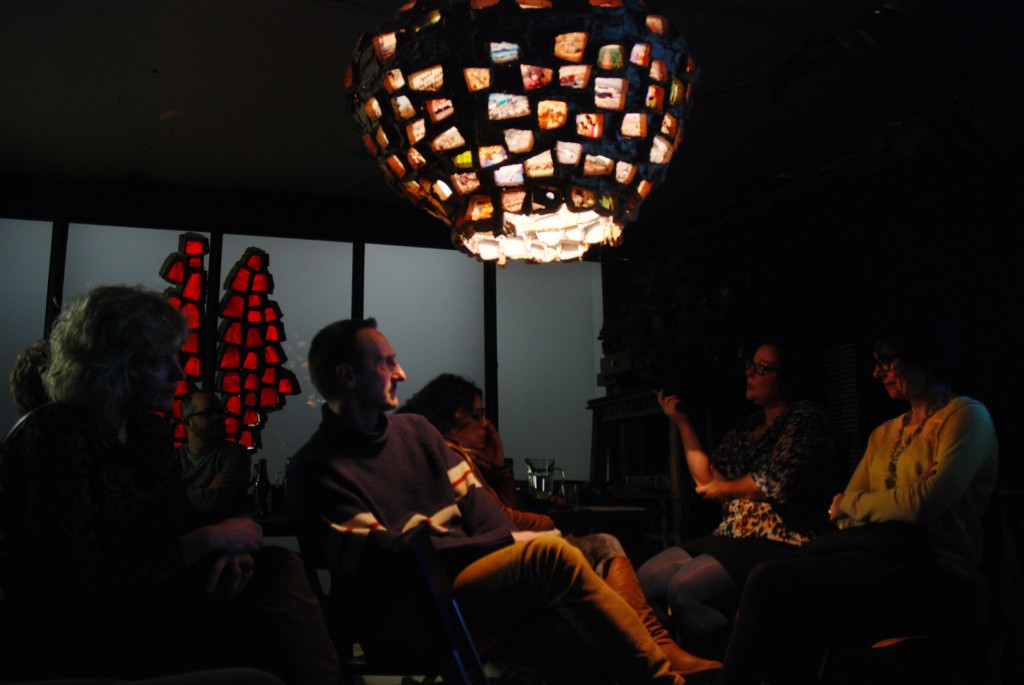
Q&A with Ruth Baumeister inside Rob Voerman’s installation ‘The Fifth Season’, Upstream Gallery Amsterdam, 2014.
Baumeister’s talk was followed by an interview:
HdB: While working on the interview with you on my blog we found out that there are more issues that we would like to address. The session here at Upstream Gallery is a good moment to ask you more about Jorn’s relationship to technology, especially within the discourse of primitivism in architecture. I do know that Jorn has always been interested in science, but I can’t remember reading anything specific about technology as such, or how this would relate to the discourse of primitivism. Could you first say something more about that?
RB: Asger Jorn certainly did not elaborate on technology in architecture as much as he did on the relationship between science and art in his theories, but he does take a clear position. In Pour la forme he states that he is not against functionalism as long as it is for the benefit of people. But if it becomes an end in itself and thus dictates the life of people, then it becomes a problem.
I would argue that he takes the same position when it comes to technology. And even though he criticizes the heroisation of technology by the early century avant-garde, e.g. the futurists, Le Corbusier, Gropius, etc., it does not mean that he is critical of technology in principal. That is also what distinguishes his reception of primitivism from the one by the arts& crafts movement, for example. While Morris and Ruskin reject what technological progress and industrialization has brought about and propagate instead a return to a pre-industrial production and society, Jorn in general accepts developments of industrialization and technology and looks into the future.
If you look at his artistic work, the mural for the Statsgymnasium in Aarhus is a good example for this. You could argue, that he took on the methodological approach of prefabricated industrial production and applied it to a very archaic, if you want “primitive” crafts as ceramics. He created this relief of enormous dimension, by dividing it into over a 1000 singular pieces that he formed, burnt, colored and burnt again in a workshop in Italy and then loaded the whole thing onto a train, shipped it to Aarhus, where it was eventually mounted on site. For the craft production of ceramics, that was very unconventional and certainly technologically advanced.
Thus, the way Jorn created this art piece comes down to his effort to renew an atavistic artistic technique by introducing a new methodological approach. Similar developments you can see in the contemporary digital crafting of ceramic tiles for example.
HdB: One of the other, related issues that we wanted to touch upon is regarding Jorn’s belief that architecture should not be the materialization of a preconceived plan. I think that in relation to this, you wanted to bring up contemporary digital technology as a way to open up new prospects for creating a new architecture, an architecture that can adapt to change (as was one of Jorn’s major demands). Could you tell us more about these developments, and perhaps give some examples?
RB: In his criticism of functionalist architecture, Jorn hit the point of what architects and planners struggle with today, especially when it comes to urban planning. Most often, before a plan materializes, it is outdated and that questions the discipline of planning as such. In his theories, Jorn makes a plea for a living architecture, which he defines as an architecture that is capable of adapting to the ever changing needs of its users. Architecture, as it has been practiced traditionally as well as by the avant-garde of Jorn´s time, works with preconceived ideals, that have a very limited flexibility and are therefore in general not capable to adapt to the ever changing needs of people.
Roberto Matta, for example, whom Jorn met in the late 1930ies in Paris, was originally educated as an architect, worked for Le Corbusier, but finally resigned from architecture and devoted himself entirely to the arts. The reason for this was that he could not identify with any architectural approach and claims, for a living architecture, for spaces, that should be adaptable to human beings. The problem both, Jorn and Matta bring up here is that life is a changing entity while architecture is static. Both Jorn and Matta write in their theories about how to introduce the aspect of time and process.
What would open up new perspectives nowadays for them are the recent developments in parameter planning for example, where the parameters that constitute the planning process can be modified throughout the process. When it comes to your question of primitivism, contemporary development of participatory planning are also interesting, where a good share of what was formerly the work of the architect, especially for the housing sector, is now taken over by other participants, e.g. users, laymen, etc.
HdB: Jorn’s ‘primitivism’ is very much in line with the idea that any human action, institution or custom is at its purest at the moment of inception, and this idea very much informed his thinking about architecture, and its role in society. How do you feel that this stands in relation to Jorn as a highly ethically and politically motivated artist, a position that seems to precede and pervade anything he did as an artist? Would you agree with me, that the rhetoric of ‘spontaneity’ connected to his practice sometimes seems to be at odds with that? Or should I rethink my idea of what spontaneity is when it comes to Jorn?
RB: First of all, I would avoid talking about purism when it comes to Jorn´s ideas in general. What he does is criticizing Western (architectural) culture and in this respect he argues, that every child could do better, because he or she had not been “spoiled” by this what he conceives as indoctrination. I do not see this to be a contradiction to the fact that he is a highly ethically and politically motivated artist, the contrary. In addition to that, I do not see why as an artist you could not be ethically and politically motivated and work spontaneously at the same time? Apart from that, I think his practice is highly complex and differentiated. Depending on which art work you would choose, spontaneity would play a different role. Luckily, especially once he was internationally recognized and sold well, he was frantic about repeating himself and therefore searched for new means of artistic expressions all of his life. This is what makes him so interesting for me as an artist, but, of course, difficult, if you want to pin point him on one specific approach or methodology he uses.
HdB: Jorn was brought up in a very religious family, but stepped out of the religious community at a rather young age to engage with Marxist politics and philosophical questions concerned with explaining the fundamental nature of being and the world that encompasses it, as well as theories from a range of other disciplines. This led him to take on a ‘materialist’ stance, a view on the world that doesn’t seem entirely devoid of spiritual/religious aspects. I’m not sure what terminology to use … Think for instance of the way that he talks about ornamention as the ‘geometry of life’, and as ‘the grammar of substance’, how all matter including human beings are part of one and the same and how the movement of each affects the movements of other(s), or other matter. Would you feel inclined to relate his religious upbringing to his later attitude towards life?
RB: To me, the answer to this is very obvious and therefore rather short. He did refuse his religious upbringing, because of all the restraints that came with it. He did not resent spiritualism, the contrary. If you look at his oeuvre, a lot of his work is very spiritual and the fact that he declared himself to be an atheist, does not mean that religion would not play an important role for him anymore. Especially if you look at the titles of his art works for example, many of them are quotes or recall scenes from the bible. When it comes to the vacuum, that a rejection of God leaves, the “Sinnfrage” it unevitably poses, I think he simply substituted religion with art and he was certainly not the only modernist artist who did so. Just think of Wassily Kandinsky´s book “Über das Geistige in der Kunst”, München, 1912, which was published in many editions and read by a whole generation of artists.
HdB: You also indicated that you would like to refer to Le Corbusier’s famous statement that the house should be a machine for living, in contrast to Jorn’s idea of a house as a machine for expression which is connected to his critique of the modernist paradigm of “Form follows function”. The word ‘expression’ has very strong connotations that have to do with the personal, with authorship …. I know that Jorn had strong opinions about that. I think that I read somewhere that he for instance insisted on the idea that a painter has to sign his paintings. Not as a mark of his genius, but to be transparent about its process of making. How do you perceive Jorn’s use of the term ‘expression’ in relation to notions of authorship?
RB: I never got across the quote that you refer to, but I think it is not so much the authorship as such, that he wants to emphasize, but the subjectivity that lies in art and architecture as a human expression. This is what he wanted to see emphazise and nurtured and a lot of modernist artists and architects strived to eliminate at the same time. In terms of architecture, Jorn pointed at the façade of a building as a surface for expression and a means of communication. It is important to remember here, that he realized the power of architecture in this respect when he worked for Le Corbusier at the 1937 world exhibition in Paris, Le Corbusier´s Pavillon de Temps Nouveaux was explicitly instrumentalized to communicate the political agenda of the Popular Front on the one hand and Le Corbusier’s and Ciam’s agenda for architecture and urbanism on the other. This experience cannot be estimated enough when it comes to Jorn’s understanding and being an artist. As a very young age, he discovered left winged politics for himself and that coincided more or less with his discovery of the arts. For the first time in Paris, at the world exhibition he sees both, politics and arts coming together. Throughout his whole life, Jorn had an agenda – politically, artistically and also personally – and art was a means or maybe even a necessity for him to express it.
HdB: Jorn tried to change the relation between science and art by diminishing the dominant functionalism of science. As you have pointed out also elsewhere on my blog, this has certainly a high relevance for us living in what Guy Debord (1967) called the “Society of the Spectacle”, in which authentic social life has been replaced with its mere representation. In terms of architecture the representation of a building in mass media has become more important than the building itself. You mention however many more issues that Jorn raises which are also connected with the discussion in architecture theory today: identity in architecture and urbanism, architecture as an instrument of social policy, parameter design, to name a few. Could you say more about these connections?
RB: As I have explained earlier, he learned about the power of architecture as a means of expression at the World Exhibition in Paris in 1937. Upon his return to Denmark after this stay, he engages into the debate for a tower for the Arne Jacobsen´s design for the Aarhus City Hall for example. Jacobsen won the competition for the design of a new City Hall, which raised a debate among general public and politicians, who claimed, that this building could be anything, an office building, school, etc. Instead, they claimed a building that they could identified with and demanded a tower, as a sign that is visible in the skyline of the city. Jorn and his friend, the Danish architect Robert Dahlman Olsen, whom he had met during his stay in Paris, took side of the people and in a couple of articles explained the capacity and necessity of a tower as a means to transmit identity.
Regarding the issue of architecture as a means of social policy, I think Jorn, as much as modern architects themselves totally overestimated themselves in this respect. A piece of architecture or urban fabric is a very complex entity and there are many factors, e.g. climate, investment parameters, building law, ect. that determine what it is, not only the idea and/or the will of a single architect.
HdB: Now you have finished your doctoral thesis, I would be curious to know if so far your findings have been consistent with your previous findings on Jorn, or whether you have across anything truly surprising?
RB: Unfortunately, I have to correct you here. I have not finished my doctoral thesis now, but I already finished it in 2009. That means that it took me another 5 years to revise and publish it in English, meaning that I continuously encountered new surprising findings. I came to realize though, that I simply had to stop, because there is no end to a study on Jorn, unless you set it yourself. Right after Architecture Sauvage, Asger Jorn´s Critique and Concept of Architecture went into print by the end of last year, I started another book on Jorn, Asger Jorn, in image, words and forms. It is a general, image based introduction to his oeuvre in English, Danish and German, which will come out at the end of this month and I feel that this is enough now. Time to burry my hero! Who would care about what a 100 year old fellow has to say these days anyhow…?!
HOUSE MUSEUM ASGER JORN, ALBISSOLA MARINA, 2013

House Museum Asger Jorn, Albissola Marina, 2013. Courtesy: Comune di Albissola Marina/MuDA Museo Diffuso Albisola

House Museum Asger Jorn, Albissola Marina, 2013. Courtesy: Comune di Albissola Marina/MuDA Museo Diffuso Albisola

House Museum Asger Jorn, Albissola Marina, 2013. Courtesy: Comune di Albissola Marina/MuDA Museo Diffuso Albisola

House Museum Asger Jorn, Albissola Marina, 2013. Courtesy: Comune di Albissola Marina/MuDA Museo Diffuso Albisola

House Museum Asger Jorn, Albissola Marina, 2013. Courtesy: Comune di Albissola Marina/MuDA Museo Diffuso Albisola

House Museum Asger Jorn, Albissola Marina, 2013. Courtesy: Comune di Albissola Marina/MuDA Museo Diffuso Albisola

House Museum Asger Jorn, Albissola Marina, 2013. Courtesy: Comune di Albissola Marina/MuDA Museo Diffuso Albisola

House Museum Asger Jorn, Albissola Marina, 2013. Courtesy: Comune di Albissola Marina/MuDA Museo Diffuso Albisola

House Museum Asger Jorn, Albissola Marina, 2013. Courtesy: Comune di Albissola Marina/MuDA Museo Diffuso Albisola

House Museum Asger Jorn, Albissola Marina, 2013. Courtesy: Comune di Albissola Marina/MuDA Museo Diffuso Albisola

House Museum Asger Jorn, Albissola Marina, 2013. Courtesy: Comune di Albissola Marina/MuDA Museo Diffuso Albisola

House Museum Asger Jorn, Albissola Marina, 2013. Courtesy: Comune di Albissola Marina/MuDA Museo Diffuso Albisola

House Museum Asger Jorn, Albissola Marina, 2013. Courtesy: Comune di Albissola Marina/MuDA Museo Diffuso Albisola

House Museum Asger Jorn, Albissola Marina, 2013. Courtesy: Comune di Albissola Marina/MuDA Museo Diffuso Albisola

House Museum Asger Jorn, Albissola Marina, 2013. Courtesy: Comune di Albissola Marina/MuDA Museo Diffuso Albisola

House Museum Asger Jorn, Albissola Marina, 2013. Courtesy: Comune di Albissola Marina/MuDA Museo Diffuso Albisola

House Museum Asger Jorn, Albissola Marina, 2013. Courtesy: Comune di Albissola Marina/MuDA Museo Diffuso Albisola

House Museum Asger Jorn, Albissola Marina, 2013. Courtesy: Comune di Albissola Marina/MuDA Museo Diffuso Albisola

House Museum Asger Jorn, Albissola Marina, 2013. Courtesy: Comune di Albissola Marina/MuDA Museo Diffuso Albisola

House Museum Asger Jorn, Albissola Marina, 2013. Courtesy: Comune di Albissola Marina/MuDA Museo Diffuso Albisola

House Museum Asger Jorn, Albissola Marina, 2013. Courtesy: Comune di Albissola Marina/MuDA Museo Diffuso Albisola

House Museum Asger Jorn, Albissola Marina, 2013. Courtesy: Comune di Albissola Marina/MuDA Museo Diffuso Albisola House Museum Asger Jorn, Albissola Marina, 2013. Courtesy: Comune di Albissola Marina/MuDA Museo Diffuso Albisola

House Museum Asger Jorn, Albissola Marina, 2013. Courtesy: Comune di Albissola Marina/MuDA Museo Diffuso Albisola

House Museum Asger Jorn, Albissola Marina, 2013. Courtesy: Comune di Albissola Marina/MuDA Museo Diffuso Albisola

House Museum Asger Jorn, Albissola Marina, 2013. Courtesy: Comune di Albissola Marina/MuDA Museo Diffuso Albisola
THE ADVERTISEMENT MONSTER AND THE BAN ON BILLBOARDS IN SAO PAULO
Interview with curator Jorn Konijn on Asger Jorn’s “advertisement monster”, the ban on billboards in São Paulo, São Paulo’s local politics, and art.
About this interview
While interviewing Ruth Baumeister for this blog I was reminded of one of Asger Jorn´s statements on advertising: “If artistic or overarching human cultural values are to be developed, this can only happen at the same time as greater and greater restrictions are placed on the roar coming from the advertisement monster and its appeal to rampant individualism.” (From: Façade-Art – Towards a New Architecture, 1950). I asked Ruth about the ban and its effects on the city’s architecture, or rather the (collective) experience of it. My question resulted in a series of relevant and critical questions from Ruth’s side, and from there in an interview with independent curator and consultant Jorn Konijn.
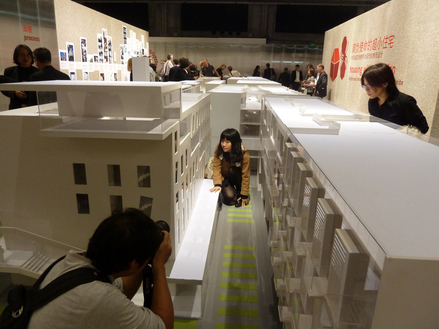
'Housing with a Mission - Dutch and Chinese designs for housing of the future', curated by Jorn Konijn and Ole Bouman, Shenzhen Architecture & Urbanism Biennale 2011
HdB: Jorn, could you briefly explain your relationship to São Paulo first, and your experience of its local political landscape?
JK: My relationship with Brazil, and in particular with São Paulo, dates back to roughly 10 years ago. First, I went there as a tourist, visiting friends, later I lived and worked there part time. I mostly work within the field of culture, as a curator and project manager of cultural projects.
Brazil’s local political landscape is very fascinating. It’s on the one hand still very traditional and patriarchal. Especially in the North of Brazil one feels being thrown back to a few centuries ago where a few families control the city. Both São Paulo and (back with a vengeance) Rio de Janeiro are extreme power bases, operating seemingly independent from the federal government in Brasilia. Its ruling party – the PT, the socialist party – is one with huge power which results in typical large scale problems of for instance corruption. Religion is also extremely powerful which results into strange political alliances. For instance, in the last presidential elections Green Left candidate Marina da Silva created an alliance with the Evangelic Movement, an extremely conservative religious movement comparable with America’s Born Again Christians. Strangely enough, the former Mayor of São Paulo Kasab was an independent candidate.
HdB: Could you summarize the facts about the ban? When and by whom was it issued?
JK: The ban on billboards in São Paulo was actually not that much of an extremely discussed or fought over decision. I personally only noticed it when it was being pointed out to me by friends. The decision was made by former Mayor Kasab. One of the main theme’s in his election was the liveability of the city. Unlike Rio, São Paulo does not have much natural beauty and many people refer to the city as one made out of concrete and cars. Kasab tried to improve the liveability by removing all the billboards in the city. Smaller signs located on the facade of a shop are still allowed.
Once it is pointed out to you that the signs are gone, you actually do notice a striking difference. One specific industry was not very happy with the decision which was of course the advertising industry. They suffered a huge blow with the ban, which resulted in the job loss of many.
HdB: How about the political motivation? The reporter in this short film http://www.youtube.com/watch?v=U1Nmnv0Ospg claims that the law was originally proposed by a left-wing political party, and the motivations of the Mayor that received the credits for it are questioned.
JK: As far as I know it really is Kasab’s law. Left wing political parties are not very strong in São Paulo, which is the liberal economic powerbase of Latin America. Rightwing-liberal parties seem to dominate local politics; only recently São Paulo has chosen a socialist mayor (Fernando Haddad), the successor of Kasab. Haddad appointed new Ministers for Culture, two left-wing powerhouse politicians (Juca Ferreira and Marcello Araujo). He also appointed a State Secretary for Urban Planning and Urban Affairs (Fernando de Mello Franco, an important architect in São Paulo). All and all the appointing of these figures seem to create a very interesting political framework in both the city and the state of São Paulo. This will undoubtedly keep the ban on billboards and will surely implement other actions for further improvement of the life in the city; the regeneration of Sao Paulo’s downtown (including dealing with São Paulo’s most horrifying drugs area – Crackolandia) will surely be dealt with. I must add that many of these actions were already started by liberal state council man Carlos Augusto Calil who left office last year.
HdB: What can you tell about the visual impact of the ban? Some people that I know have been to São Paulo, and told me that the city still looks like it is overloaded with adverting. On the internet I found a ‘before and after’ video’ http://antiadvertisingagency.com/sao-paulo-before-and-after/that seems to present quite a spectacular difference … . How would you describe the visual transformation?
JK: I personally always enjoyed São Paulo. It’s actually a very liveable and surprisingly green city. Yes, the city has problems (the notorious traffic and the disastrous flooding situations during heavy rains) but overall it is a city that is both pleasant to live and work. The billboards can feel very much in your face, so yes, the city looks more calm now. I however could every once-in-a-while also appreciate São Paulo’s crazy creative advertising. The billboards were often highly entertaining with (literally) going outside the box. The creativity of many billboard advertising was surprising.
HdB: Do you know what advertisement strategies have replaced the billboards? I came across an article on the web from an company that commissioned local artists and art collectives to paint panels that include only a modest sized logo. People would be made aware of the company’s products through media campaigns. It seems a pretty hybrid thing to me to say the least. http://www.fastcocreate.com/1681353/advertising-comes-back-to-sao-paulo-streets-via-graffiti#1
JK: Advertising agencies still try to occupy public space in different ways: advertising in busses, subways or actually physical people carrying signs and walking or standing around with signs hanging on their bodies or waving huge flags trying to lure in customers into their shops.
But also, the ban on advertisement resulted in more mural art-work to fill the empty spaces that were left with the removal of the billboards. The city government started a cultural program which is called Cidade Limpa (clean city) in which they commission local street artists to create giant murals. Some of them, especially those of graffiti artists such as Os Gemeos and Tity Freak, have become landmarks within the city. São Paulo’s latest mural tribute to the great Brazilian architect Oscar Niemeyer forms another important landmark.
HdB: Asger Jorn believed that artistic or overarching human cultural values can only be developed collectively. Captalism’s individualism would be in the way of that, and commercial advertising would enhance this sense of individualism, of thinking of ourselves in the strictest sense of the word. Would you tend to agree upon that, and hence regards the ban on billboards a good thing?
JK: A lot of things are said and written about São Paulo’s ban on billboards. I don’t think it is either a good or bad thing. One thing that I find fascinating about it, is the fact that a (local) government is actually strongly concerned with the liveability of the city and also dares to take radical actions to improve this. In many parts of the world one can see governments heading in the complete different direction, pulling back from a subject like this. For instance by selling it’s city public space to private parties… or perceiving policies for urban strategies only by creating the next iconic architectural landmark. In São Paulo actions like this are being undertaken as if it is the most normal thing on earth.
CONTEMPORARY ARCHITECTURAL PRACTICE AND JORN’S IDEAS ON ARCHITECTURE
Interview with Ruth Baumeister
Part 2: Contemporary architectural practice and Jorn’s ideas on architecture
Ruth Baumeister is a researcher, critic and teacher of architecture theory and history, originally educated as an architect, based in The Netherlands. She is the editor of Fraternité Avant Tout – Asger Jorn’s writings on art and architecture, 1938-1958, 010 Publishers, Rotterdam, 2011 and she is currently working on the publication of her doctoral thesis L´Architecture Sauvage. Asger Jorn´s Critique and Concept of Architecture, forthcoming Spring 2013, nai010 Publishers, Rotterdam. Apart from her extensive knowledge on Jorn, and her efforts to make Jorn’s writings accessible to a broader audience, I appreciate what she does because whenever she gets to speak about Asger Jorn, she tries to connect his thinking and practice to the contemporary.
HdB: In Fraternité Avant Tout you devoted a paragraph to ‘the relevance of Asger Jorn’s writings today’ which you conclude saying: “Jorn’s reflection on the significance of the image not only as a means to express artistic imagination but to produce realities, and his emphasis on the form as the built material articulation of such, thus has the potential of making an interesting contribution to the contemporary discourse in architecture theory.” (p.11) Could you summarize the arguments you use to build up to that conclusion?
RB: “In the beginning was the image”, is the title of a painting Jorn did in 1965 and like many of his titles this is a direct reference to the Bible, “In the beginning was the word” as a way of explaining human existence in the world. By doing so, he is claiming that the image is more important than thought, or, given the fact that he articulated this during the 1950ies, you can also argue that he demanded to give art preference over science or, at least tried to change the relation between the two by diminishing the dominant functionalism of science. This has certainly a high relevance for us living in what Guy Debord 1967 called the “Society of the Spectacle”, in which authentic social life has been replaced with its mere representation. In terms of architecture the representation of a building in mass media has become more important than the building itself. That is simply a fact today. But there are many more issues he raises which are also connected with the discussion in architecture theory today, identity in architecture and urbanism, architecture as an instrument of social policy, parameter design, etc.
HdB: When thinking about Jorn’s approach to architecture I was reminded of the Urban Independent project by artist/architect Marjetica Potrc, which was carried out around 2002. In this project she interconnected five settlements/communities in various parts of the world in a research into “real-life examples of individual initiative in modern global society.” The examples she researched all had in common a re-thinking of “the role of the individual in society (the individual is becoming an equal participant in shaping urban environments), private space (gated communities and shanty towns are among the most successful forms of urban life today); self-reliance (and its link with self-sustaining technologies); ecology (global concerns are transformed into individual practice); and even beauty ( …).” http://www.potrc.org/urbanindependent/ How do you feel these developments relate to Jorn’s thinking?
RB: There is definitely a correlation between such movements and what Jorn had in mind when he was searching for a cooperation between artists and architects in the 1940ies. What you righteously point out is his interest in the individual within society and in relation to this, his interest in post-war housing and urbanism. One of his biggest criticism of early modernist concepts is that they were conceived for and from the perspective of the individual, meaning individual celebrated architects on the one hand, and individual housing on the other. In any case it was not targeted towards the society as a whole. But he does not mean that the subjective interest of the individual does not count. It is about empowerment of the individual. About individuals taking control of their lives and taking responsibility of what they are doing. He understands urbanism to be a pragmatic tool of social planning and subsequently, introduces his materialist philosophy into the issues of post-war urban planning. Samuel Mockbee´s rural studio, or projects like “uit je eigen stad” here in the Rotterdam harbour, which is about re-appropriation of our environment for example, or the project with the artistically colored building facades, initiated by the Major of Tirana, Albania are just a few of the many projects that deserve to be mentioned here. In the end, it has to be mentioned that Jorn, really did not provide a coherent theory which was supposed to be “applicable” in architecture and/or urbanism. But his reflections are highly theoretical, interesting and amusing, even though often fragmented and sometimes even confusing and contradictive.
HdB: I am sure that in your upcoming book L´Architecture Sauvage. Asger Jorn´s Critique and Concept of Architecture you will be paying a considerable attention to Jorn’s plea for paying attention to irrational needs, such as ornament (Jorn: “the grammar of substance; geometry of matter itself”). Jorn himself (rhetorically) asked if fulfilling such needs must be left to reactionary forces in our midst. What tendencies in architecture nowadays pay attention to the ornament in an interesting way you think? And in what way is ornamentation politicized in the architectural discourse?
RB: Indeed, Jorn´s claim for irrational needs provide one of the major arguments of his critique of functionalism in architecture in specific and in modern life in general and the ornament of course plays a central role in this. What is important to mention though is, even if Jorn back in the 1940ies has not seen it like that, as much as the functionalists and rationalists wanted, the ornament was never really banned from architecture, it was denied and therefore often articulated in a different, not necessarily obvious manner. Postmodernist architecture with protagonists like Robert Venturi and Denise Scott Brown, certainly did a great deal for the rehabilitation of the ornament, especially in the US. One of the key modern buildings in Europe, consciously celebrating the ornament and thus making it “socially” acceptable again within the community of architects was Jean Nouvel´s Centre du monde arab, 1981-87, in Paris. One of the firms that certainly plays with the ornament in a poetic, interesting manner today is Herzog& De Meuron. You are asking me about politicization of ornamentation in the architectural discourse today…? I´m sorry to say but this does not occur to me at all. Architecture today is anything but political, it is a commodity, a service, a status symbol, you name it!
The article http://www.complex.com/art-design/2011/02/the-top-50-architectural-achievements-of-the-modern-world/olympic-stadium-the-bird39s-nest, where I found the image also, states that “Swiss firm Herzong & de Meuron looked to traditional Chinese ceramics for inspiration and employed iconic contemporary artist Ai Weiwei as artistic consultant.”
HdB: Jorn once said: “If artistic or overarching human cultural values are to be developed, this can only happen at the same time as greater and greater restrictions are placed on the roar coming from the advertisement monster and its appeal to rampant individualism.” (From: Façade-Art – Towards a New Architecture, 1950. In September of 2007, the city of Sao Paulo banned almost every type of outdoor advertising. Do you happen to be aware of the effects this might have (had) on the city’s architecture, or rather the (collective) experience of it?
RB: I do not know of this case and I find it hard to believe that a city of this dimension, would have the muscles to achieve something like that. I happened to be in Sao Paolo last year in fall and to me, this place appears to be an intensification of various different conditions, rather than one city, but anyway. I do know of a similar example, much smaller in scale. A couple of years ago, I was invited to give a lecture on Jorn´s house in Albisola at the DAC (Danish Architecture Center) in Copenhagen, which was in relation to a show called Instant Urbanism. I remember there was an Austrian artist, who painted all advertisement in a street yellow and by doing so, made the public space of the street appear in a very different manner. Our cities would certainly benefit a great deal from actions like that, but before this can happen, we have to get rid of capitalism. Good luck with that one!
HdB: Thanks for pointing out the Instant Urbanism project Ruth, I will look into it. The story about Sao Paulo however, really is true though. Obviously, not ALL outdoor advertisement is gone, but it looks like at least they got rid of the billboards. And maybe it concerns one of the city districts only, I am not 100% sure but it doesn’t look like it. This http://www.smartplanet.com/blog/cities/in-billboard-less-city-can-businesses-survive/1431 is a link to an article from 2012 which also goes a little bit into the effects of the ban on new strategies for advertising. I think it is fascinating to see that one individual mayor can establish something whith such impact, and apparently make it last! The downside is that of course companies just find other ways to advertise. I am not sure if I would appreciate to be confronted with other forms of ‘advertisements’ all too often. Although I had a good laugh when I cam across this video on Youtube: http://www.youtube.com/watch?v=Wkys9RmWoU0!
Additional comment HdB: Ruth asked me to make an additonal comment to this interview, phrasing her various more skeptical questions to the Sao Paulo situation. She for instace insists that the difference between the ‘before and after situation’ is hardly noticeable. It is at least obvious indeed that there still is a lot of outdoor advertisement. She asked me to look into the actual reason for banning the bill boards. We both agree that the Sao Paulo mayor probably did not have similar motives as our ‘comrad’ Jorn! Ruth Baumeister also points out that there might be a parallel with China here, which due to its undemocratic system can effectively implement energy saving laws. I think Ruth raises some valid and interesting questions, but I am nevertheless curious about the effects of the ban and will therefore look into the Sao Paulo situation more. To be continued …
JORN AND THE NOTION OF “ARCHITECTURE SAUVAGE”
Interview with Ruth Baumeister
Part 1: Jorn and the notion of “an architecture sauvage”
Ruth Baumeister is a researcher, critic and teacher of architecture theory and history, originally educated as an architect, based in The Netherlands. She is the editor of Fraternité Avant Tout – Asger Jorn’s writings on art and architecture, 1938-1958, 010 Publishers, Rotterdam, 2011 (translations by Paul Larkin) and she is currently working on the publication of her doctoral thesis L´Architecture Sauvage. Asger Jorn´s Critique and Concept of Architecture, forthcoming Spring 2013, nai010 Publishers, Rotterdam. Apart from her extensive knowledge on Jorn, and her efforts to make Jorn’s writings accessible to a broader audience, I appreciate what she does because whenever she gets to speak about Asger Jorn, she tries to connect his thinking and practice to the contemporary.
HdB: Ruth, when you participated in the seminar at the Museum Jorn in March 2012 you talked about Jorn’s sources of interest in architecture, ranging from the Paris Metropole to Surrealist interiors, his experience on working with Le Corbusier on the 1937 World Expo, and his connection with Fernand Léger. Over the years Jorn strongly critiqued functionalist architecture for in fact not being functional at all, because it doesn’t take man’s irrational sides into account. From this critique he developed what his fellow-Situationist Guy Debord called an “architecture sauvage” to which – in line with Jorn´s political views – the idea of an architecture for people, for the broad mass, was a central notion. Before drawing parallels with the contemporary (part 2 of this interview), I would like to ask you to describe what ‘architecture sauvage’ stands for, also in Jorn’s thinking about architecture?
RB: Let me clarify something upfront: Jorn never really “developed” an architecture sauvage, this is just a notion, which I retrospectively chose to describe his philosophy of architecture. And, as you righteously mentioned, I borrowed this notion from Guy Debord, who used it when describing Jorn´s private estate in Albisola in his obituary to his fellow artist´s death in 1973. Debord refered to Claude Levi-Strauss here, whose research on primitivism was a great inspiration for one of Jorn´s most beautiful books: La langue verte et la cuite from 1968. The reason why I chose Debord´s expression as a title for Jorn´s concept of architecture is because it implies the key aspects of Jorn´s architecture theory, e.g. rejection of the classic as well as an appreciation of primitivism, experiment and spontaneity.
HdB: I think that the closest thing Jorn came to realize as an architecture sauvage must be his house in Albisola, Italy, where he (partially) lived between 1957 until his death. You have been enthusiastically telling me about your visit there, could you summarize what fascinated you most?
RB: As an architect, what fascinated me most when I visited the place for the first time about 15 years ago, was the fact that it was full of seemingly ‘unprofessional’ construction details, which actually performed greatly. I remember that when I looked at all these constructions and combinations of materials employed, I thought to myself that this was exactly what my teachers back then in architecture school were telling us NOT to do. The whole project is conceived as a “work in progress”.
To be fair, I do not want to fail to mention, most of the construction work done in Albisola was not done by Jorn himself, but by Umberto Gambetta. He lived in Albisola and worked for Jorn as a sort of housekeeper for some time. Gambetta was a very good, but ‘unsophisticated’ handyman, who was still able to master some of the old, local building techniques. Jorn himself promoted Albisola as a cooperation between the two of them, in photographs, publications, etc. What I witnessed there during the “reconstruction” process was that anything that was by Jorn, was glorified and anything done by Gambetta, pretty much declared as irrelevant. This is how they ended up destroying the art work, what is left there today has unfortunately very little to do with what I say 15 years ago when it was abandoned.
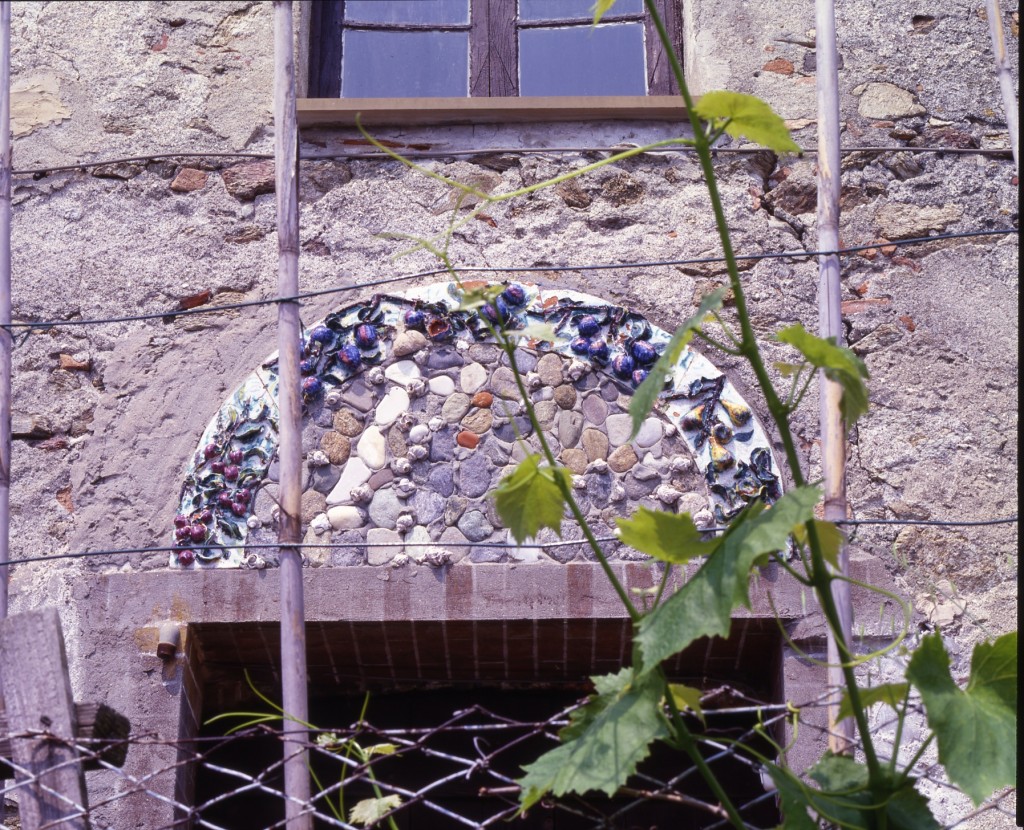
Jorn’s house in Albisola (2004). Copyright Ruth Baumeister and group of Bauhaus architecture students, 2004
HdB: At the Jorn seminar in March 2012 we concluded that over the years Jorn managed to turn the house and garden into a fascinating constellation of elements, and we then discussed what term could be used to best define this constellation. I remember most participants seemed to agree with the term ‘disjunctive synthesis’ – a synthesis not based on the idea of harmony but on the inclusion of contradictions – between technology, architecture and nature. Such a synthesis Jorn believed to be the basis for the fulfilment of the central needs of human beings. It was however not the term that you coined, and I wonder in retrospect how what you think of the notion of a ‘disjunctive synthesis’ in this context?
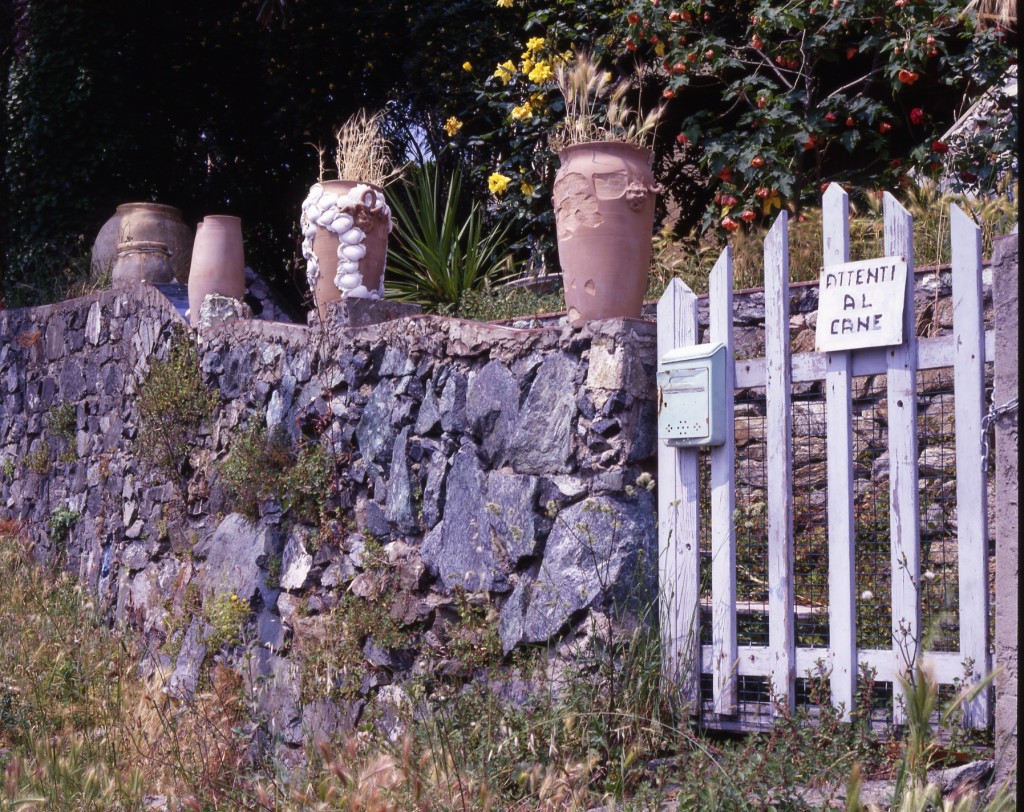
Jorn’s house in Albisola (2004). Copyright Ruth Baumeister and group of architecture students, 2004.
RB: In principle, I am not interested in “coining terms” with any of the work that I am doing. This is what marketing experts do if they want to sell a new project and as effective as it might be as a strategy for promoting Jorn´s ideas or even myself as a researcher, it is not my intention. I think “coining” became a sickness in our profession ever since Koolhaas started putting his copyright labels on every little fart he was producing. People did not get the irony behind this and started coining and copywriting everything ever since.
Jorn in his writings builds up concepts, contradicts himself and destroys them the very next moment. He himself was the one to protest most about any categorization of –isms in art history. What interests me instead is following his thoughts, tracing down where they come from in their historical context and most of the times their relevance for today then occurs automatically. – I would not necessarily say that “Jorn believed [the synthesis itself] to be the basis for the fulfilment of the central needs of human beings”. I think it is more about a strategy. As a materialist, he claims to see the world as it is, like it or not, and work from there. He is against idealism, which ignores anything that does not fit the perfect picture and this is what made functionalism fail, he says. Jorn promoted spontaneous artistic articulation as something very crucial and as such any architectural plan, which represents a preconceived idea, he doomed to be outdated before it gets built. What he envisions instead gets most closely materialized in his own private house and garden in Albisola. He adapted an “archival” approach to the subject matter here.
There is a very interesting article by Claire Gilman on Jorn´s modifications , where she compares Jorn´s overpaintings with the works of Duchamp. She concludes her analysis with the result that Jorn, other than the Dadaists, who were striving for a cancellation of meaning or the creation of a new meaning with their overpaintings, works with an additive strategy to the existing art work. Thus, his modifications become palimpsest, which still reveal the traces of the various different phases of creation. He works more towards the idea of coexistence of the old and new and therefore treats the existing with respect, rather than completely overruling it. I think that this is also the approach he used in Albisola. I do believe that architects back then and also today can learn from this. On top of this, yes, it also led him to creating a synthesis in Albisola, whether in harmony or by including potential contradictions, that is up for you to decide. But what should be clear is that Jorn never believed in the concept of pureness or harmony as being something to strife towards. In the end, isn´t modernism about softening all these contradictions which occur to us life anyway?
Part 2 in my serial interview with Ruth Baumeister is ‘Contemporary architectural practice and Jorn’s ideas on architecture’. Part 3 ‘L’architecture Sauvage – Asger Jorn’s critique and concept of architecture’ was a public lecture and interview at Upstream Gallery, Amsterdam.
